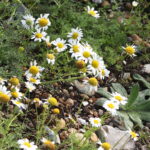Back in February I came along to Cuckmere for one of SNHS’s Saturday nature walks. It was a rather miserable day but we still managed to see a lot of interesting wildlife! Read more about that walk here.
Summer has pretty much been and gone, and you might think there is not much to see so late in the season, but you might be surprised. In early September I retraced our steps to see what was about.
The path is a bit tucked away, on the right just after you get through the gate from the carpark so a little quieter than the obvious ones. This time it was partly fenced off, presumably for the benefit of the ponies who were grazing in the distance. The ponies do a fantastic job grazing down the vegetation so that wildflowers can thrive, and you are likely to spot them (or at least their hoof prints and dung!)
There were still plenty of bright yellow blooms about, mainly ragwort and fleabane, two pretty flowers in the daisy family. Both were busy with insect life including bees, hoverflies and a number of Painted lady butterflies. Another fantastic plant here is Hemp-agrimony (not at all related to hemp and sometimes nicknamed Raspberries and Cream!) This grows in damp grassland and along riverbeds with frothy pinkish flowers which attracts all kinds of insects.
Walking along this section I was accompanied by a chorus of grasshoppers and a couple of cheery robins. Robins are quite vocal at the moment, setting out their own territories for the winter after sharing one with their mates earlier in the year. This is to ensure they have enough food over the winter.
Many of the flowers have finished flowering but their remains are still interesting. Look out for spiky heads of teasels, rich with seeds that birds like goldfinches flock to. Look out for seed heads like the umbrella shaped Wild carrot. Many in the daisy family look similar with dandelion “clocks” but look closely and you will see little hairy helicopters that “fly” the seeds to a new location to germinate. The size and shape of these seeds vary significantly, and can help identify some of the more difficult plants in this family.
The path eventually meets the main path and up to 20 swans were gliding serenely on the water and more birds in the distance (should have brought binoculars!) I veered right to walk along the shore edge, where a few lovely asters were coming into bloom. At the first junction I veered right on a narrow path running between meanders of water on both sides. As I stooped to inspect a flower two egrets flew in, one landing only feet away from me!
As I passed along the path it got rather muddy (just like February!) But it was worth it for the peace and quiet along this stretch, waders and gulls in the river and views towards the Coastguard’s cottages.
Eventually I reached the junction near the beach and settled down for my picnic lunch near the dragons teeth! Look out for the fascinating lichen and mosses growing on these old concrete structures. This area is full of sea lavender (you might still spot a bit in flower, or the many neat rosettes of round leaves marking each plant as it fades. Mayweed which looks like a big daisy plant was also still blooming too.
Once on the beach, most people head straight on or walk parallel to the sea, but I took a right turn along the flowing river where the bank was a vast swathes of shells underfoot and shingle plants including sea kale, rock samphire, teasel and orache reigned. A handsome wheatear was flitting around on nearby rocks watching me, this migrant will soon be heading off to warmer climes!
On the return I enjoyed views of the glasswort which is starting to turn vivid Autumn red! Near the well trodden path, look out for the lovely furry leaves of silverweed.
You can stay on the main path back but I crossed back over the river by the gate/style where the ponies were drinking and took the quieter path the other side back to the road bridge and was rewarded with the view of a greenshank feeding as I approached the end. As I left there was a noisy flapping of great wings as two majestic swans took off, even drowning out the noise of the traffic
You can download a spotting guide for this walk here soon
We are always interested to hear about your favourite walks and the wildlife you have seen, do share your routes and sightings!
BAS













